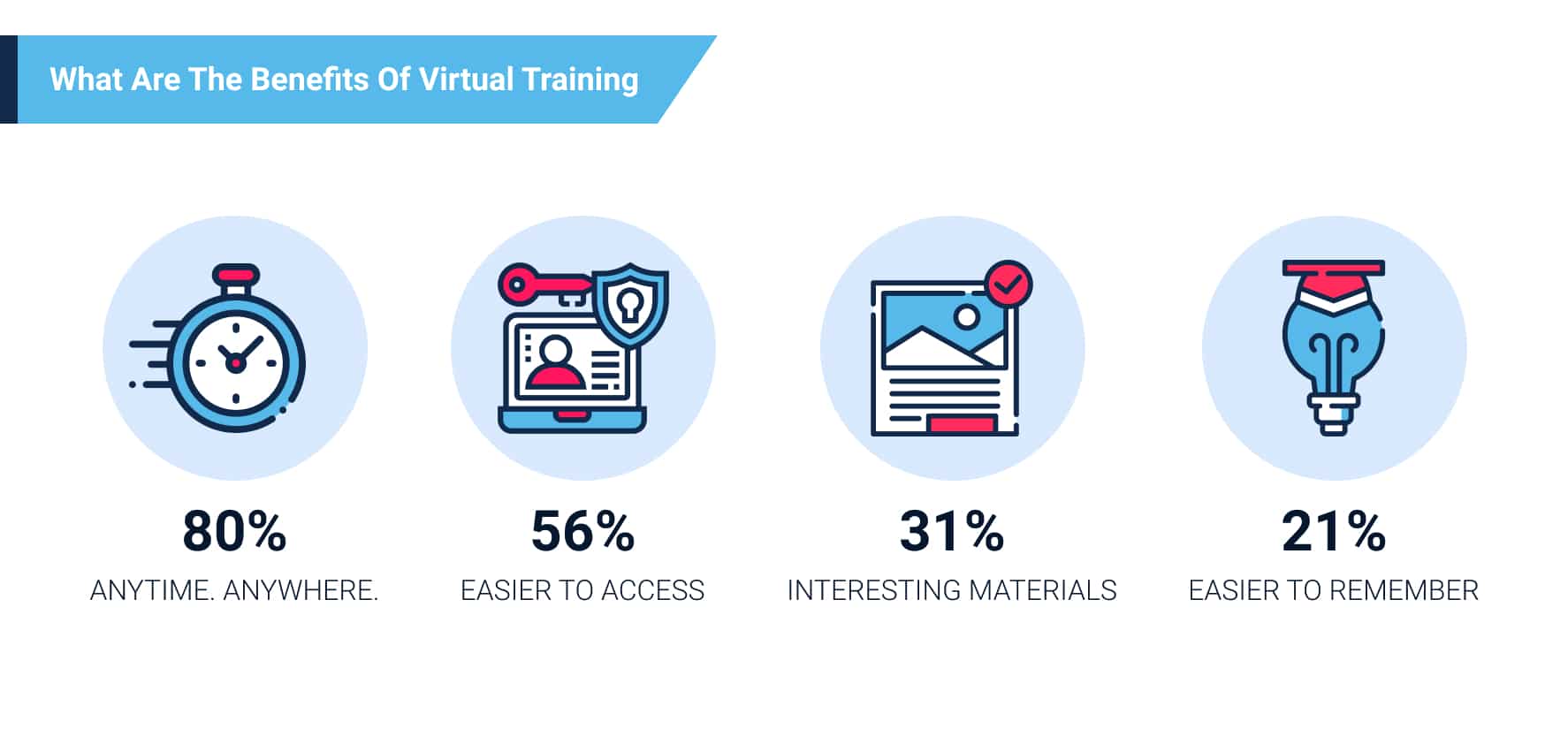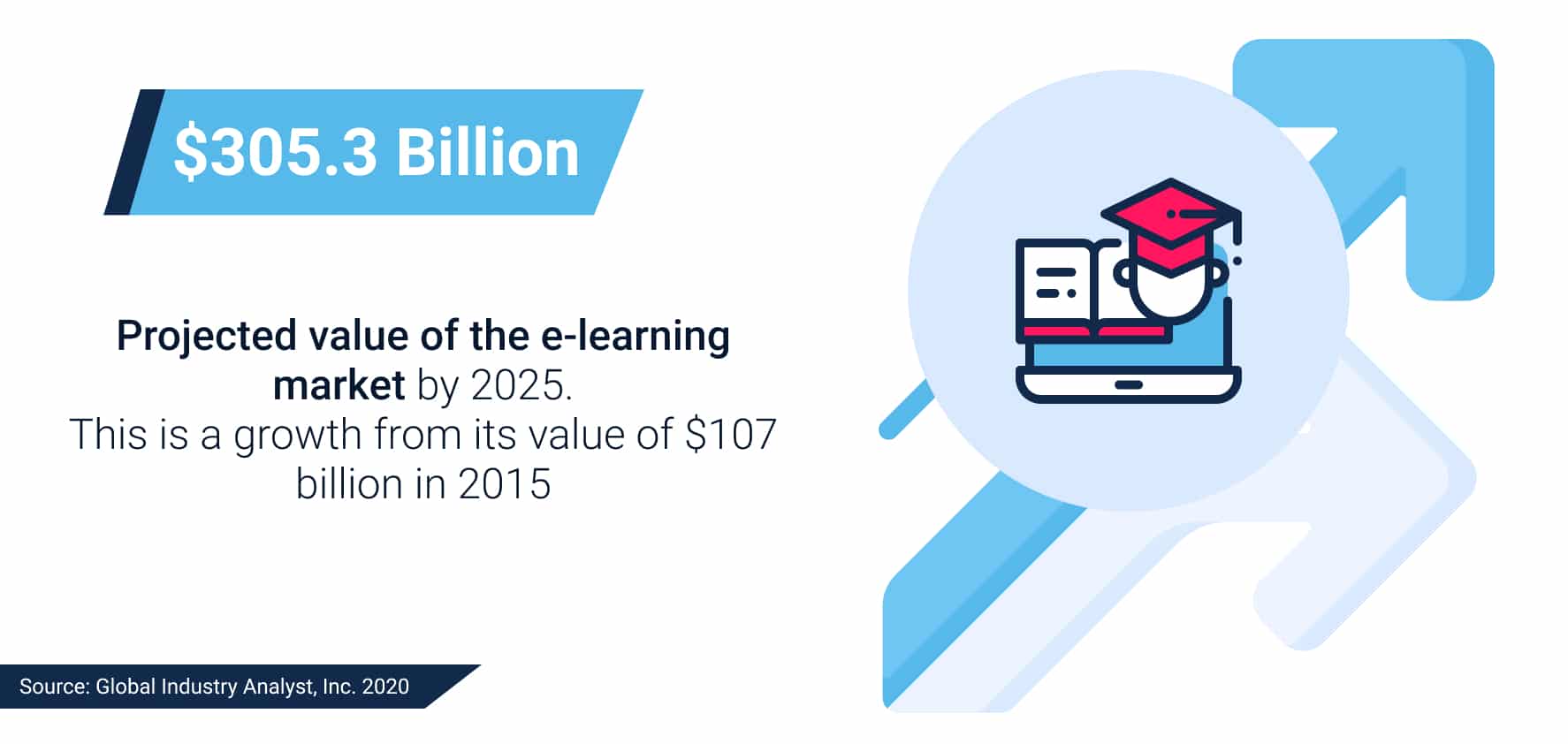6 Key Features of a Top Custom E-Learning Development Solution
 11 January 2021
11 January 2021The global pandemic has spurred the growth of online education and custom e-learning software solutions. The industry was already developing at a rapid pace before 2020, but the demand has surged. Custom e-learning development is now a wide domain that encompasses modern tools for children and adult learners.
Research has shown that interactions play a pivotal role in engaging learners of all ages. E-learning is not limited to schools. The format is increasingly popular with businesses. Through platforms, adults improve their expertise, test their knowledge, and acquire new skills.
When organized properly, remote learning boosts employee performance. Data from the Association for Talent Development (ATD) shows that spending $1,500 on training per employee annually causes profit margins to jump by around 24%. Thus, the interest is hardly surprising.
According to a report by Global Market Insights, this market is projected to exceed $375 billion by 2026. Many companies are willing to capitalize on its growth. Discover popular types of custom e-learning solutions today and the advantages they bring. This overview can also provide ideas for startups.
Types of Custom E-Learning Solutions
1Mobile Learning
Mobile technology is a fixture of the modern reality. Consumers expect to have flexible access to any digital product, including learning tools. Training on the go is the new norm. Thanks to mobile learning, users can gain knowledge and improve their skills wherever they are.
Companies need to keep up with the times to stay in business. mLearning is a way to achieve that goal, as it is accessible from any location. Students no longer have to attend classroom sessions. Nor do they need a laptop or a desktop computer to study. Apps like Google Classroom, Khan Academy, and Udemy have redefined learning.
2Blended Learning
Here, technologies are used in combination with conventional face-to-face methods — hence the name. In many cases, blended learning is focused on the provision of online modules and resources, while the interaction between learners mainly takes place in the classroom. Feedback and assessment may occur online or in a physical class. For example, Ernst & Young used the model to cut the classroom time in half. Its system replaced 2,900 classroom hours with 700 hours of web-based learning, 200 hours of distance learning, and 500 hours of classroom time.
The key challenge is to find the right balance between the two worlds. Creators need to decide which components should be offered digitally, and which should be left for real-life engagement. An efficient solution provides seamless integration between online content and face-to-face interaction.
Drop us a line and let’s discuss your idea.
3Gamification
Games are another proven way to make learning more efficient. Teachers have been using them for decades. Today, gamification boosts the efficiency of e-learning software. Members of the audience can achieve their educational objectives in a fun and fascinating environment.
Students can learn through engaging, competing, and playing. Gamification makes the process immersive. For instance, McDonald’s introduced an addictive and fun training game for its staff.
4Animated Explainer Videos
These are concise videos created to meet the specific needs of a company. The purposes of these videos may vary. First, they can help promotional efforts by showcasing a product or service. Secondly, they may update stakeholders on the latest figures. Thirdly, they may be used by HR teams for training and development programs.
Sometimes, less is more. A well-made explainer video can deliver a deeper message than several pages of text. Videos and supporting audio transfer knowledge from the source to the recipient efficiently.
5Scenario-Based Learning
Scenario-based learning systems can expose learners to different simulated environments. They are widely used for the development of soft and interpersonal skills. The most common subjects are workplace safety and security, privacy, and customer interaction. Scenario-based learning is useful in any field that requires decision-making skills. For instance, it is part of Lloyds Bank’s induction program.
6Conversion of Existing Flash Courses
In 2020, Adobe Flash was discontinued. Creators of an e-course that runs on this technology may have it converted into HTML 5. Outdated content brings little value. After transformation, it may be accessed on the go from any mobile device.
Alternatively, a professional developer may turn existing e-learning content into a powerful combination of HTML + JavaScript + CSS for enhanced style and interactivity. These three languages form the backbone of the web today.
7Translation and Localization
As businesses expand their geographic reach, they acquire new customers and employ people who represent different cultures. This creates the need to localize existing content to make it suitable for an international audience — both clients and staff. The accurately translated text conveys the original intent of its creator.
Content is most effective when it leverages the full power of the local language. Despite all technological advances, machine learning is still flawed. Automated translation systems are unable to provide perfect accuracy. Professional e-learning translators are skilled at adapting content for an international audience.
Must-Have Features of a Custom E-Learning Software Solution
These features are absolutely vital for e-learning platforms today. They allow smooth access and make learning more engaging. Custom e-learning design can speed up or slow down the user’s progress. From sign-in to mobile access to dashboards, here are six features that make the best custom e-learning solutions stand out.
1Single Sign-On (SSO)
This technology allows users to log in quickly without entering their password. They may choose to do it through Facebook or Google. There is no need to enter personal details.
2Clear Interface
Programs that are overly complex fail. Complicated design, confusing menus, or myriad useless features will only hamper learning. The interface must be clear, intuitive, and consistent. This way, it will facilitate learning instead of hindering it.
3Support for Mobile Learning
At present, around 3.5 billion people in the world have smartphones. An average of 76% of adults in advanced economies overall and a whopping 91% of the US population own a smartphone! Unsurprisingly, the best custom solutions are optimized for mobile use.
For instance, this includes resizing of content based on the user’s screen type. As a result, learners can access the information from any desktop or mobile device. This creates an environment where education is always a click or a tap away.
For example, consider Duolingo. It is one of the most popular and downloaded educational applications in the world. Users of the language learning app can test their skills and acquire new knowledge on the go using tablets or smartphones.
4Testing and Assessment
Today, learners can take tests online at convenient times for them, and assessment is facilitated by automation. Teachers do not have to stay up all night grading their students’ work. Mistakes are identified automatically. Machine-based evaluation can pinpoint areas of improvement in the context of a particular subject or skill.
5Gamification
In recent years, custom e-learning design services using game-like elements have been adopted by big platforms like Udemy and Coursera. The format helps to keep every learner focused and boosts engagement. Motivation through competition, scores, and badges inspires users to continue learning. Certificates and leaderboards are small reinforcements that go a long way.
Drop us a line and let’s discuss your idea.
6Dashboards and Reporting
Reporting is vital, as it shows how effective the training system is. Managers can see whether their strategies reach their goals, and which learners need additional support. Meanwhile, users may have access to their personal dashboard for progress visualization. The system may highlight their strengths and weaknesses through reports and assessments.
Other Top E-Learning Solution Features
1Learner-Centric Tools
Sometimes, one-size-fits-all models do not work. Platforms with a personalized touch enhance user experience. For example, employees may be able to build their own learning paths based on their job roles. They may have access to advanced search, select their courses or classrooms, conduct self-assessments, etc.
2Discussion Forums
Today, millions of people have at least one social media account. Online communication is an indispensable part of their lives. Additional features like online forums allow employees and students to share experiences and help each other move forward. This paves the way for collaborative thinking.
3Parents’ Collaboration
Systems created for young learners may also include features for parent engagement. Parents can access their children’s grades and view their list of courses. They can also communicate with teachers and other parents at their own convenience.
Our Experience
Good command of English is a must for international communication. Attract Group’s platform for Lingua-Airlines is a CRM/ERP/HRM system for teaching it via Skype. This versatile e-learning solution has allowed the brand to streamline multiple processes through automation. Today, the platform makes language courses easily accessible from any part of the world. It facilitates:
- communication with leads and clients,
- management of payments,
- payroll (ERP),
- recruitment of personnel,
- in-house work with staff, and
- other aspects of running the business.
The system facilitates financial, sales, and HR procedures within the organization. Managers have instant access to a wide range of processes and analytics. Meanwhile, the staff devotes more time to the process of communication with clients, which is vital for fostering customer loyalty. Both students and teachers enjoy the easy management of personal accounts. The school has been able to grow its business and expand its audience considerably.
Final Thoughts
The e-learning market is developing at a rapid pace. Custom e-learning software development makes education accessible from any location, 24/7. It allows students and their teachers to interact in an engaging digital environment. Employees in any industry can acquire new skills and hone their expertise, which contributes to their company’s bottom line. Mobile learning, gamification, automatic assessment, and reporting make learning more effective, whatever the subject.
Attract Group provides custom e-learning development services for businesses. It has created platforms for companies in different industries, from retail to healthcare. This team of experienced professionals is committed to providing high-quality solutions for the corporate world. Contact the provider today for a free quote!
Drop us a line and let’s discuss your idea.














